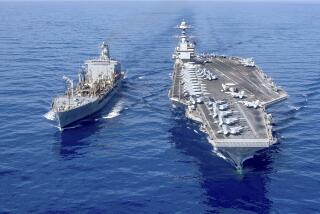Book review: ‘Obama’s Wars’
The essential outline of the story journalist and political historian Bob Woodward sets out to tell in “ Obama’s Wars” actually is fairly well known. President Obama’s agonized march to a decision on how to move forward in what he has called “a war of necessity” in Afghanistan has been widely reported and analyzed.
It’s well known, for example, that the lack of good options bitterly divided the president’s advisors and that the chief executive immersed himself in the details of the decision that ultimately produced a modified version of the “surge” strategy that the Bush administration used to stabilize — temporarily, at least — Iraq. The Joint Chiefs were similarly split over what to do in Afghanistan, as were the commanders on the ground. What Woodward’s signature brand of exhaustive reporting and access to sources — including Obama — and timely documents provide are the voices and detailed anecdotes that put flesh on the people in the White House — right down to the name-calling and back-biting.
There are sobering revelations aplenty in “Obama’s Wars,” including intelligence appraisals on Al Qaeda’s ongoing effort to recruit terrorists from among the 35 countries whose nationals don’t need visas to enter the United States. According to one briefing Obama was given, at least 20 holders of American, Canadian or Western European passports are being trained by Al Qaeda in Pakistani safe havens. Other threats abound: During the last presidential election, for example, U.S. intelligence agencies caught the Chinese hacking into the computers both the Obama and McCain camps used to run their campaigns. When the president-elect got his first private briefing from Adm. Michael G. Mullen, chairman of the Joint Chiefs, he discovered that eight years into it there was “no strategy” for fighting the Afghan war, that the contingency plan for military action against Iran dated to the Carter administration — a 90-day bombing campaign followed by a Normandy-style invasion by a force larger than the entire U.S. military — and had no plans at all for dealing with the growing Al Qaeda presence in Yemen and Somalia. While no contingency plans exist for dealing militarily with a collapse of nuclear-armed Pakistan, there is “a retribution plan” in place, developed by the Bush administration, if the United States suffers another 9/11-style terrorist attack. That would involve bombing and missile strikes to obliterate the more than 150 Al Qaeda training and staging camps known to exist, most of them in Pakistan, which presumably would suffer extensive civilian casualties.
“One of the closest held secrets of President Bush’s inner circle,” Woodward writes, “was that the president had lost his appetite for military contingency planning. The tough-talking, saber-rattling Bush Administration had not prepared for some of the worst-case scenarios the country might face.”
In fact, according to Woodward, at the last National Security Council he convened before leaving office, Bush decided to suppress a report on the Afghan situation he’d commissioned from his “war czar,” Lt. Gen. Douglas Lute. That review concluded the United States had no coordinated strategy in Afghanistan, that we were neither losing nor winning the war there, that the local government was hopelessly corrupt and that the far greater strategic threat to American security was in Pakistan.
Woodward gives a grim account of the secretive visit Vice President Joe Biden and Sen. Lindsey Graham (R-S.C.) made to Islamabad and Kabul on Obama’s behalf early in his term. They confronted Pakistani President Asif Ali Zardari over his intelligence agency’s ties to the Taliban and the impunity with which Al Qaeda operates in his country and came away without much confidence in his ability to remedy matters. Things were worse in Kabul, where there was an angry confrontation with President Hamid Karzai — who, according to U.S. intelligence, is a manic-depressive subject to wild mood swings despite medication — over his government’s corruption and general ineffectuality. U.S. military briefers told Biden that “‘we haven’t really seen an Arab here in a couple of years.’ For all practical purposes, there was no Al Qaeda (in Afghanistan). That confirmed what Biden suspected. Al Qaeda — the impetus of this war — was a Pakistani problem.” Everything the vice president saw seemed to remind him of Vietnam, which Woodward reports made him “pessimistic and more convinced than ever” that the United States had slipped into a Central Asian version of that morass.
An equally sour and alarming mission followed a Pakistani immigrant-turned-terrorist’s botched attempt to set off a car bomb in New York’s Times Square. Obama dispatched national security advisor James L. Jones and CIA Director Leon Panetta to Pakistan to confront officials there with the need to do more to end their government’s links to terror and to deal with “ Mullah Omar’s Quetta Shura and the Haqqani network, the two leading Taliban groups killing U.S. soldiers in Afghanistan.” Neither American official came away believing the Pakistanis were going to do anything of the kind.
For Jones, the inability to cut the Gordian knot of Pakistani weakness, double dealing and intractable hostility toward India means grief for the administration’s strategic approach to Afghanistan. Woodward writes that if the NSC advisor had found himself the new military commander on the ground there, he would have told the president that “the strategy is correct. But it was predicated on the fact that Pakistan would be coerced into moving more than they have been…. The Taliban war in Afghanistan was being run from these safe havens. And hundreds, if not thousands, of fighters were pouring across the border. The Taliban was taking full advantage of the safe havens to rest and train fighters before rotating them into Afghanistan for combat. In those circumstances, ‘You can’t win. You can’t do counterinsurgency. It is a cancer in the plan.’”
There are telling insights into the president’s character here. Former Clinton White House of Chief of Staff John Podesta, who managed the transition for Obama, compared him to the hyper-rational, unemotional Mr. Spock in the “Star Trek” films. “He was unsentimental and capable of being ruthless. Podesta was not sure that Obama felt anything, especially in his gut. He intellectualized and then charged the path forward, essentially picking up the emotions of others and translating them into ideas. He had thus created a different kind of politics…. But, Podesta thought, sometimes a person’s great strength, in this case Obama’s capacity to intellectualize, was also an Achilles’ heel.”
In his one-on-one interview with Woodward, Obama explained his predecessor’s failure to do critical strategic and contingency planning with some empathy: “Wars absorb so much energy on the part of any administration that even if people are doing an outstanding job, if they’re in the middle of a war — particularly one that’s going badly, as it was, obviously, for a three-year stretch there in Iraq — that’s taking up a huge amount of energy on the part of everybody. And that means that there are some things that get left undone.”
Taken together, Podesta’s insight and Obama’s analysis may tell us a great deal about why this presidency has foundered as it has.
tim.rutten@latimes.com
More to Read
The biggest entertainment stories
Get our big stories about Hollywood, film, television, music, arts, culture and more right in your inbox as soon as they publish.
You may occasionally receive promotional content from the Los Angeles Times.






